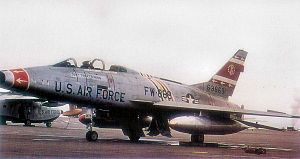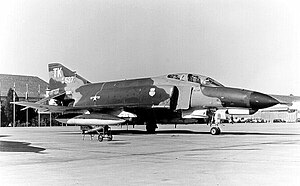353rd Combat Training Squadron
This article includes a list of general references, but it lacks sufficient corresponding inline citations. (December 2012) |
| 353rd Combat Training Squadron | |
|---|---|
Operation Desert Shield | |
| Active | 1942–1946; 1956–1992; 1993–present |
| Country | |
| Branch | |
| Role | Training |
| Part of | Pacific Air Forces |
| Garrison/HQ | Eielson Air Force Base |
| Engagements | World War II |
| Insignia | |
| 353rd Combat Training Squadron emblem (approved 27 August 1957[1] |  |
| 353rd Fighter Squadron emblem (World War II) |  |






The 353rd Combat Training Squadron is a United States Air Force training squadron responsible for Exercise RED FLAG – ALASKA held annually in Alaska.
Overview
All the activities on Alaska's three weapons training ranges – incorporating more than 68,000 square miles (180,000 km2) of airspace, 28 threat systems, and 225 targets for range and exercise operations – are planned and controlled by 353rd CTS personnel.
The three tactical ranges supervised by the squadron's range division are Blair Lakes, Yukon and Oklahoma. The Blair Lakes Conventional Range is located about 26 miles southwest of Eielson AFB. Isolated in a sub-Arctic tundra environment, this range is manned continuously and is normally accessible only by helicopter.
The Yukon Tactical and Electronic Warfare Range is 15 miles (24 km) east of Eielson. Accessible most of the year, this mountainous complex is only manned as necessary to provide electronic warfare training.
The Oklahoma Tactical Range is located within the U.S. Army's Cold Region Test Center at Fort Greely, Alaska, and is the largest of the three ranges, encompassing more than 900,000 acres (3,600 km2) of relatively flat, open terrain.
Cope Thunder's economic impact on the communities surrounding Eielson and
History
World War II
Activated on 15 November 1942 at
In late 1943, the strategic bombardment campaign over
Was relieved from escort duty and was re-equipped with
Moved to
Remained in Occupied Germany as part of the
Cold War
Reactivated by Tactical Air Command, United States Air Force on 19 November 1956, being assigned to the reactivated 354th Fighter-Day Group at the new Myrtle Beach Air Force Base, South Carolina. Equipped with North American F-100 Super Sabre fighters, the squadron participated in exercises, operations, tests, and firepower demonstrations conducted by the Tactical Air Command within the US and abroad. The unit frequently deployed to Aviano Air Base, Italy and Wheelus Air Base, Libya. Was deployed to Europe during the 1958 Lebanon crisis and was moved to McCoy Air Force Base, Florida in 1962 during the Cuban Missile Crisis. During the Dominican Civil War, the squadron deployed eighteen of its F-100s to Ramey Air Force Base, Puerto Rico to guard against Cuban intervention in the war.[2]
United States Air Forces in Europe
In 1966 the 353rd Tactical Fighter Squadron was reassigned to the
The host 401st TFW was itself reassigned to Torrejon from England AFB, Louisiana, with its operational fighter squadrons being deployed to Pacific Air Forces in South Vietnam for combat missions during the Vietnam War. The 353rd, along with the 307th TFS from Homestead and 613th from England to provide the 401st a full complement of aircraft.
At Torrejon, the squadron continued to fly the F-100D "Super Sabre." Major operations consisted of maintaining combat readiness; rotating units to other bases in Europe or the Middle East and participating in various United States Air Force, North Atlantic TreatyOrganization and Spanish Air Defense exercises. In 1970 the squadron had its aging F-100 fleet replaced, being re-equipped with
Vietnam War
In 1971, the 612th and 613th Tactical Fighter Squadrons were reassigned back to the 401st TFW from their deployment in South Vietnam as part of the drawdown of USAF forces in Southeast Asia. As a result, on 15 July, the 353 TFS was inactivated and reassigned without equipment or personnel to the 354 TFW at Myrtle Beach AFB.
At Myrtle Beach, the squadron assumed the personnel and
The squadron received new A-7D Corsair IIs upon its return to Myrtle Beach AFB, and the unit resumed training. It again deployed to Korat 31 March 1973, where it flew bombing missions until the bombing halt on 15 August 1973. The 353rd claims the distinction of dropping the last bomb and making the last strafing run of the war.
Post Vietnam era
On 18 October 1973 the squadron returned to Myrtle Beach AFB and resumed normal training activities. In 1978 the squadron obtained A-10 aircraft and flew training missions with the A-10s for over a decade, being deployed frequently to NATO bases in Germany for annual training exercises.
The unit deployed to
Returned to the United States in March 1991, and returned to peacetime training operations. Immediately began phasing down with the designated BRAC 1990 closure of Myrtle Beach AFB and the pending inactivation of its host Wing. The squadron's aircraft were dispersed, being reassigned to Air National Guard and other active Air Force Fighter Squadrons throughout the balance of 1991 and early 1992. The squadron was inactivated on 15 December 1992.
Modern era
In August 1993, the unit activated at Eielson AFB, Alaska. It became responsible for coordination of Red Flag-Alaska exercises and controlled the local training ranges.
Lineage
- Constituted as the 353rd Fighter Squadron 12 November 1942
- Activated 15 November 1942.
- Inactivated 31 March 1946
- Redesignated 353rd Fighter-Day Squadron 28 September 1956
- Activated 19 November 1956
- Redesignated 353rd Tactical Fighter Squadron 1 July 1958
- Redesignated 353rd Fighter Squadron 1 November 1991
- Inactivated 15 December 1992
- Activated 20 August 1993
- Redesignated 353rd Combat Training Squadron 1 August 1994
Assignments
- 354th Fighter Group, 12 November 1942 – 31 March 1946
- 354th Fighter-Day Group, 19 November 1956
- 354th Fighter-Day Wing(later 354th Tactical Fighter Wing), 25 September 1957
- 401st Tactical Fighter Wing, 27 April 1966
- 354th Tactical Fighter Wing (later 354th Fighter Wing), 15 July 1971 – 15 December 1992
- 354th Operations Group, 20 August 1993
- 611th Air Operations Group, 4 September 2003
- 354th Operations Group, 1 October 2006 – present
Stations
|
|
Aircraft
|
|
Campaign streamers
- World War II: Air Offensive, Europe; Normandy; Northern France; Rhineland; Ardennes-Alsace; Central Europe; Air Combat.
- Vietnam War: Vietnam Ceasefire
- Southwest Asia: Defense of Saudi Arabia; Liberation and Defense of Kuwait
Decorations
- Distinguished Unit Citation: European Theater of Operations, December 1943 – 15 May 1944; France, 25 August 1944.
- Presidential Unit Citation: Southeast Asia, 12 October 1972 – 21 January 1973.
- French Croix de Guerre with Palm: 1 December 1943 – 31 December 1944
- Republic of Vietnam Gallantry Cross with Palm: 12 October 1972 – 28 January 1973
- Air Force Outstanding Unit Awards: 1 October 1962 – 1 December 1963; 15 July 1971 – 31 May 1972; 1 May 1974 – 30 April 1976; 1 July 1978 – 31 May 1979; 1 June 1979 – 22 May 1981; 1 July 1985 – 30 June 1987; 1 May 1990 – 15 March 1992; 20 August 1993 – 31 August 1993; 11 September 2000 – 10 September 2002.
References
![]() This article incorporates public domain material from the Air Force Historical Research Agency
This article incorporates public domain material from the Air Force Historical Research Agency
